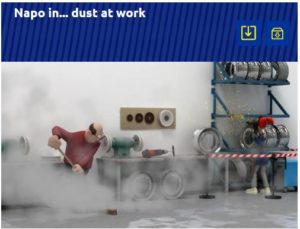Employers in the construction, manufacturing, food and beverage, and agricultural sectors, among many others, are well aware of the barriers that language differences present to communicating accurate and complete safety information to workers. Signs that use icons instead of language can, to a limited degree, help get critical information across. Another method is film.
But films that are narrated in one language may not provide the needed verbal explanation of the moving image to those who do not understand that language. One group based in Europe has come up with another approach—a type of animated film on workplace safety, which is not limited by language.
An Answer to Diversity
The group calls its concept NAPO, which it describes as “an original idea conceived by a small group of [occupational safety and health] communications professionals in response to the need for high quality information products to break down national boundaries and address the diverse cultures, languages, and practical needs of people at work.”
The films feature characters in the world of work, faced with safety issues. “The main character, Napo, and his partners express themselves in wordless language,” say the creators. “Their stories have an educational value. They provoke questions and stimulate debate on specific aspects of safety at work. Sometimes they provide practical solutions or lead to them.”
Napo Deals with Dust
One 7-minute film called NAPO … in Dust at Work illustrates the following dust hazards:
- Unloading dust-containing bulk material from a dump truck;
- Machine mixing of flour in a bakery;
- Using a blaster to strip paint from a steel structure;
- Floor sweeping near an ignition source;
- Mixing concrete;
- Power sawing stone blocks;
- Dust produced when feeding grain to farm animals;
- Woodworking sawdust; and
- Ignition sources near large amounts of accumulated combustible dust. The example used is a grain silo.
Practical Solutions
Some, but not all, of the above scenes include safety practices. For example, the proper use of respirators and equipment vacuums (as well as vacuum maintenance) is shown. In other cases, such as using spark-producing machinery near explosive or flammable dust, the unfortunate consequence animated is probably sufficient to convey what the safer practice is.
Easy Watching
Not all types of dust hazards are shown. For example, we noted the absence of a scene showing the dangers of combustible dust that accumulates in unobserved places, such as above a suspended ceiling. But given that the film is only 7 minutes, the message—that dust hazards can exist in many forms in the workplace—is conveyed clearly and in a somewhat humorous manner that should make the film easy to watch for employees, regardless of their language skills.
In addition to NAPO … in Dust at Work, the website enables viewing of 26 films on topics as diverse as risk assessment, electrical hazards, slips and falls, back injuries, and hazardous chemicals.
Showing the films to employees may not satisfy government training requirements in the United States, but they can be an effective way to get across a key safety message when language gets in the way.


